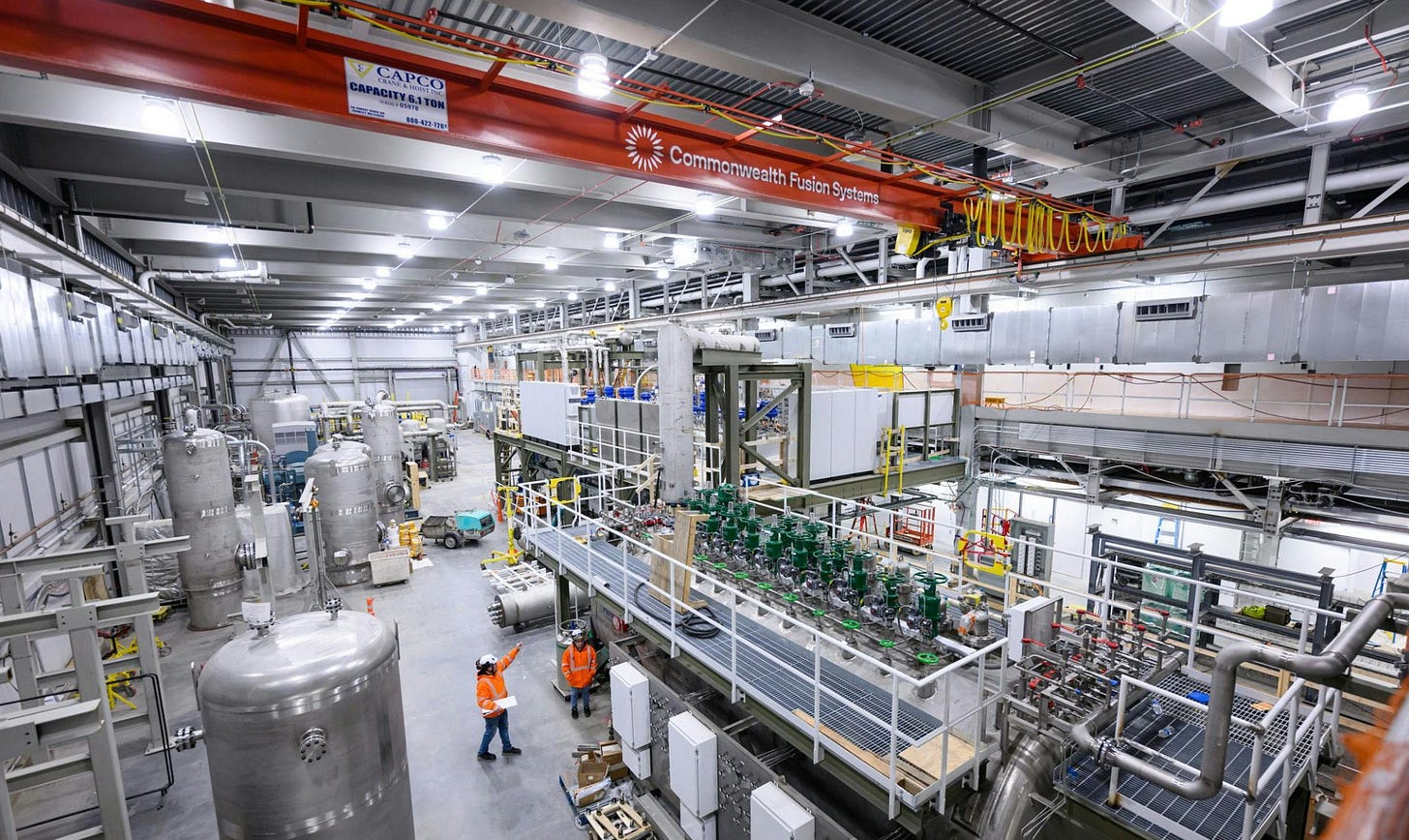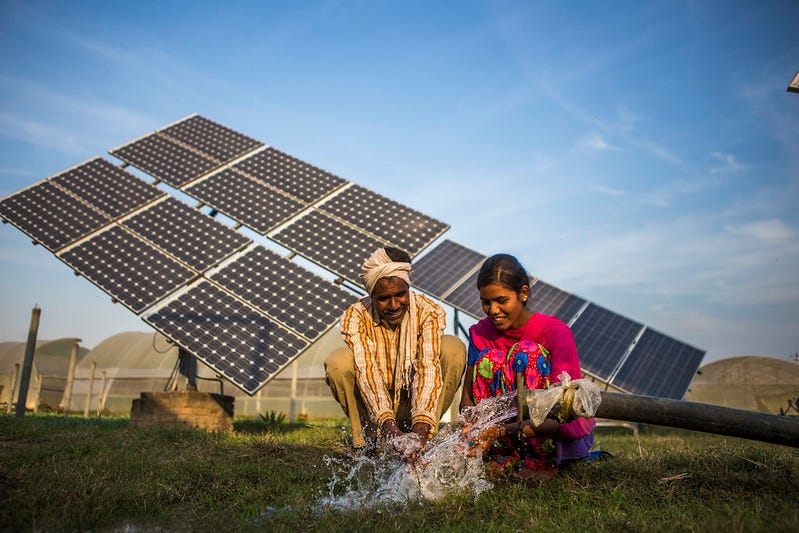Nuclear bets pile up as AI frenzy rolls on
Welcome to Callaway Climate Insights, your daily guide to global climate finance. Upgrade your subscription now and take advantage of our big Labor Day sale.
Summer sale alert!
We’re having a big Labor Day sale. Callaway Climate Insights will be available to new subscribers for less than $5 a month for the first year. Take advantage now to get the best of our daily global climate analysis. If you’re a free subscriber, upgrade now with the best deal of the year — our special Labor Day sale offer.

Not only did AI mania on Wall Street survive Nvidia’s NVDA 0.00%↑ earnings report this week but it seems to be spreading to other markets. Nowhere is this more evident than in the nuclear industry, where waves of so-called smart money are descending on new and unbuilt technologies.
Shares of Oklo, a California company working to develop the first small modular nuclear reactors, are up more than 1,000% in the past year, all on the strength of a good story and enthusiasm for a nuclear future that involves scores of movable reactors that can be shipped wherever they are needed. To date, none have been built.
But the big news this week is on the even more experimental side of nuclear — fusion energy, which seeks to combine atoms to make nuclear power instead of splitting them to make unlimited energy. Commonwealth Fusion Systems, a Massachusetts company regarded as one of the furthest along in developing this nascent technology, said it raised some $863 million in a series B2 round that included investors such as Stanley Druckenmiller, Morgan Stanley MS 0.00%↑, Google GOOGL 0.00%↑ and, of course, Nvidia.
Commonwealth says the fund raise is the second largest ever round of money raised in “deep tech and energy” since, well, its first round of $1.8 billion four years ago. It said it would use the money to complete a machine in Massachusetts that will demonstrate fusion, called SPARC, to more investors, and to build its first commercial power plant in Virginia, designed to operate with local electric grids and produce about 400 megawatts of clean energy.
The enthusiasm around these new technologies is an offshoot of the primary AI story, in which giant tech companies will need unlimited sources of new energy to power data centers to operate the AI systems of the future. And though we are compelled to remind readers — again — that these technologies don’t yet exist in any sort of commercial form, in contrast to other clean energies such as solar and wind, in this new global race to AI supremacy, nobody wants to miss out.
Earlier this month, China announced a $2.1 billion investment in state-owned China Fusion Energy Co., its own fusion champion. While closer to home, Helion Energy in Washington State, has raised money from Open AI’s Sam Altman and Softbank and already has a deal to sell fusion energy to Microsoft MSFT 0.00%↑ , if and when it has a product to sell. Commonwealth has a similar deal with Google.
Helion’s valuation is about $5 billion after its last raise while Commonwealth Fusion’s valuation is expected to leap to about $8 billion or $9 billion after this week’s raise. The Fusion Industry Association said 53 separate fusion companies have raised as more than $9 billion from investors in public and private funding. No fusion companies are as yet public, but investors can play the theme through larger energy companies and tech companies that are private investors.
If all of this is starting to look familiar to you, then you’ve probably been in the markets for as long as we have. But you never know. Maybe this time it is different.
Don’t forget to contact me directly if you have suggestions or ideas at dcallaway@callawayclimateinsights.com.
Follow us . . . .
Twitter | LinkedIn | Facebook | Instagram
Sunshine State falls short of its solar potential
. . . . Despite its abundant sunshine, Florida ranked 18th among the 50 states in the percentage of electricity generated from solar in May, writes Bill Sternberg. Solar accounted for only about 12% of the power generated in Florida, trailing non-balmy states such as Massachusetts, Maine, and Vermont by wide margins. Sternberg takes a look at the factors behind this and finds that it’s not all politics, as one might imagine in a state run by a Republican governor. His findings are a lesson to leaders of every state seeking to take advantage of its natural resources to develop energy for its citizens, especially in weighing energy availability with big business priorities.
Brazil’s attempts to lead on climate change are falling short as COP30 nears
. . . . When Brazil was chosen to host the United Nations climate change conference later this year in the port city of Belém, the Brazilian government thought it was an opportunity to solidify the country’s climate leadership efforts, writes Michael Molinski. But as the November COP30 conference approaches, Brazil is finding its own efforts at climate change ─ indeed those of the entire would ─ have been diverted away from climate change in favor of more tangible, economic actions. And Brazil itself is not the climate change leader that it once was. Molinski examines the politics and business behind this and what’s at stake as the climate world prepares to descend on a very small city on the edge of the Amazon Basin.
India tariffs a huge benefit for solar - for India

. . . . While the White House’s doubling of tariffs against India to 50% this week are expected to roil imports of key products such as textiles and jewelry, the solar industry in India is looking on the, uh, bright side.
India recently surpassed 100 gigawatts in solar power production, enough to power as many as 100 million homes for a month but had been suffering from lack of product as many of the solar panels produced were being sent to the U.S. and other export markets.
Withdrawal of the U.S. from that supply route means more solar products can be directed toward India’s domestic markets, enabling it to become a global leader in solar, with some say it soon rivaling China. The Hindu Times this week said the tariffs will be a “blessing in disguise,” quoting Pinaki Bhattacharyya, a co-leader of the Renewable Energy CEOs Committee of the country’s chamber of commerce.
Indeed, India Prime Minister Narenda Modi has vowed not to allow President Donald Trump’s trade bullying to interfere with the country’s rapid transition to renewable energy, partly funded by proceeds from the sale of oil to Russia. So, in slapping additional tariffs on another large American ally, the White House is putting America’s renewable business further behind global competition.
No doubt other countries are examining similar ways to benefit domestically from U.S. tariffs. For U.S. solar importers, the tariffs simply cut off another major import market, as China is already for the most part closed.
The era of Trump tariffs will become known for many economic earthquakes, but stopping the global energy transition to renewables will not be one of them.
Editor’s picks: Abrupt Antarctic climate shifts; plus, offshore CCS project
Watch the video: Rapid changes in the coldest place on Earth could have dangerous consequences for years to come, thousands of miles away. CBS News reports: In a new study, experts warn that abrupt and potentially irreversible environmental shifts in Antarctica could dramatically raise global ocean levels, resulting in catastrophe for future generations.
First commercial offshore CCS project
The world’s first commercial offshore carbon storage facility started operating this week off the western coast of Norway. Joint venture partners Shell, Equinor and TotalEnergies said the first volumes of CO₂ have been injected and stored as part of Norway’s Northern Lights carbon capture and storage project. The goal is to cut industrial carbon dioxide emissions by capturing carbon from smokestacks and injecting it beneath the North Sea seabed for permanent storage, Reuters reports. The CO₂ is being stored in a reservoir 8,530 feet below the seabed, marking a major milestone for CCS, the companies said. Captured CO₂ is liquefied, shipped to a terminal, and pushed through a 68-mile pipeline into the seabed’s geological reservoirs about 1.6 miles below the ocean floor. The first CO₂ injection came from a cement plant in southeast Norway. Norway’s state-backed project currently has a storage capacity of 1.7 million tons of CO₂ per year and targets an increase to 5.5 million tons by 2030, according to published reports.
Latest findings: New research, studies and projects
ESG and investment value
This paper, titled “Does ESG Information Deliver Investment Value? A High-Dimensional Portfolio Perspective,” assesses whether ESG information helps build more efficient portfolios. Instead of treating ESG as a monolith, the authors say, they build on a high dimensional information set of more than 200 ESG characteristics and employ a host of robust portfolio construction methods designed to avoid overfitting in this setting. From the abstract: “Our results show that ESG information is not redundant, increasing the portfolio Sharpe Ratio by up to 25% in-sample, compared with using financial information alone. However, out-of-sample benefits are insignificant as estimation errors offset any information advantage. We also show that optimal use of ESG information does not necessarily imply positive sustainability, as portfolios contain both green tilts to factors like human rights and brown tilts to factors like sin stocks. Furthermore, using ESG metrics provides no measurable risk reduction compared with using financial characteristics alone.” Authors: Giovanni Bruno, Felix Goltz and Antoine Naly, Scientific Beta.
More of the latest research:
Wildfire and Financial Stability of U.S. Regional Banks in California
Debt, Climate, and Development in Asia and the Pacific: Breaking the Vicious Circle
Words to live by . . . .
“Indigenous people, local communities, young people, women and girls, should be leaders of climate action and not victims of climate policies.” — Archana Soreng, member of the UN’s Youth Advisory Group on Climate Change.






So, tell me, do they have fusion nuclear reaction yet? If not, I'd wait on investing. Back in February 1969, over 50 years ago, I took a chemistry class at Berkeley. One day the professor brought in three young guys who worked out at Livermore to talk about fusion. They hoped that they might have a working model in four or five years. I haven't heard anything about fusion reaction since, but did I miss something? As far as I can tell, it could be another 50 years, and that will be too late for the planet. Nice try, people pushing this, but no cigar.